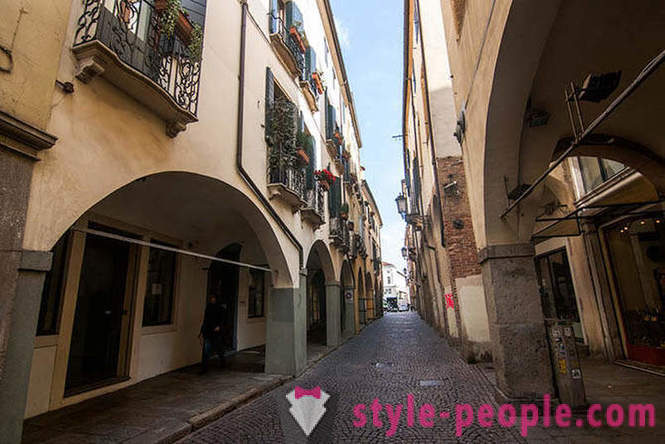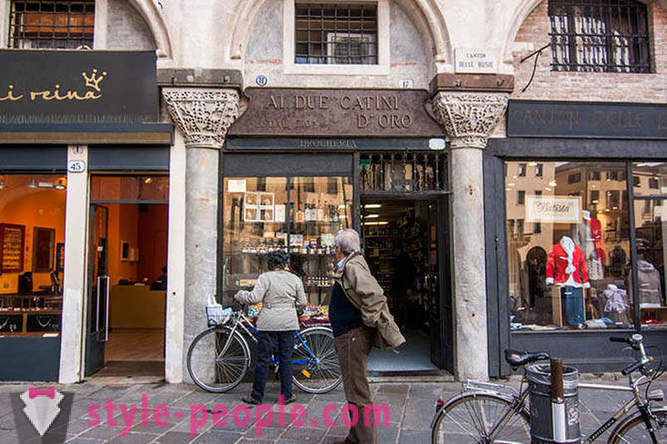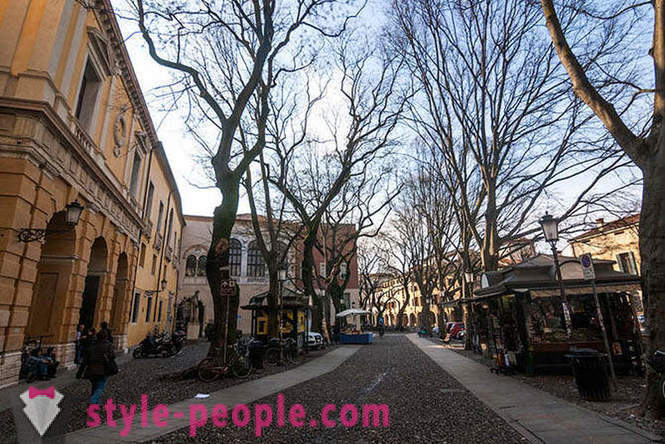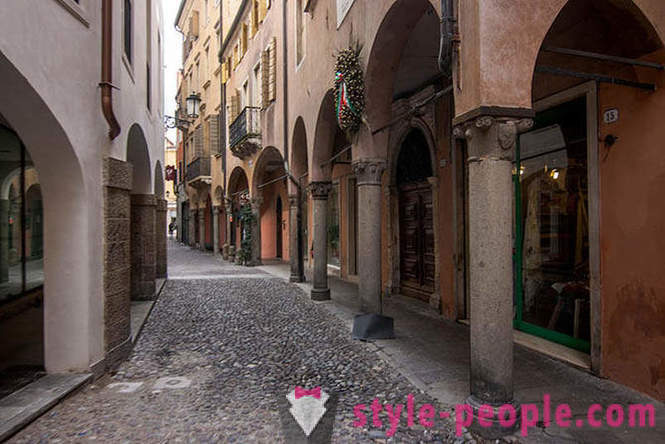Walk through the Italian city of Padua
• Walk through the Italian city of Padua
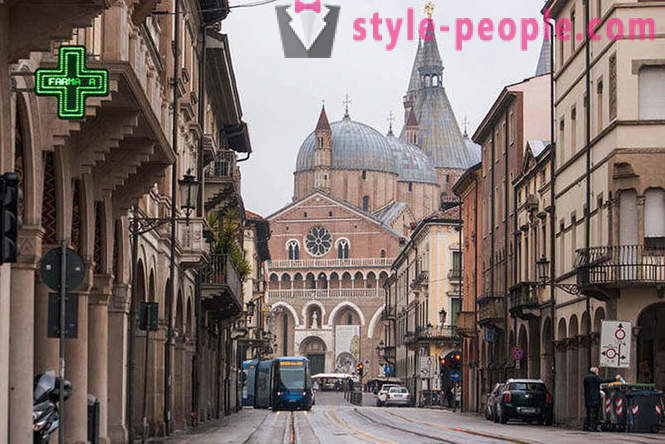
Padua - one of the major cities of the Veneto region. The first settlements in this place any more in the XI century. BC. e. During the Roman Empire, there already existed a large city Patavy. In the Middle Ages, the city was ruled by different families of power - Ghibellines, Scaligeri and Carraresi until it was included in the Republic of Venice in the XV century.
Since the XIII century. the city became a center of pilgrimage, t. To. It is here that kept the miraculous relics of St. Anthony. As during the life of one of the most revered Franciscan, he was canonized almost immediately after his death. After another half-century in Padua completing the construction of the huge Basilica of St. Anthony, or simply Il Santo.
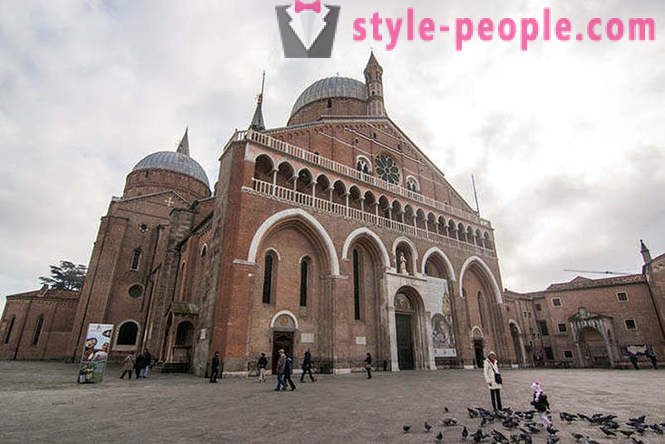
The popularity of Anthony of Padua is not extinguished until now. The temple opens its doors early in the morning and closes at night, services are held every 30 minutes (this schedule can not be found in any Italian church, even in cathedrals in many cities). Every year the shrine of St. Anthony has more than 6 million people!
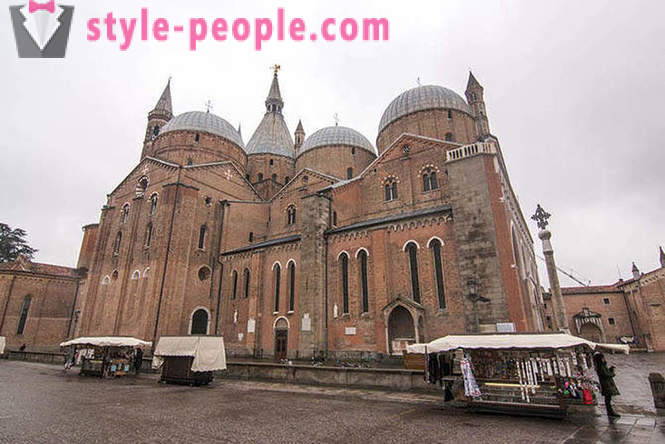
Basilica combines architectural elements of different styles. By Gothic church attached Romanesque facade, "Byzantine" in the image of the dome of the Basilica of St. Mark's in Venice and the bell tower, like minarets.
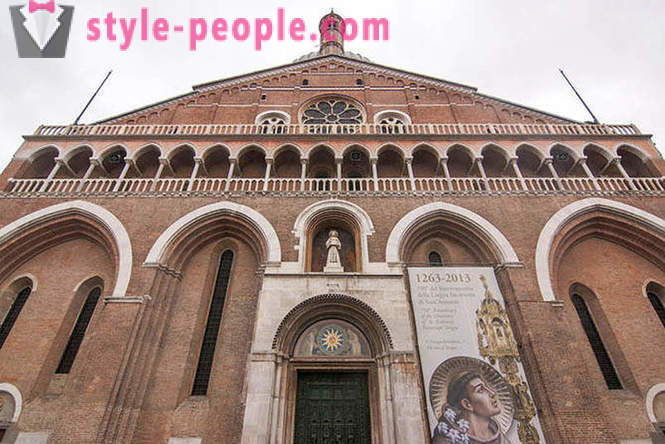
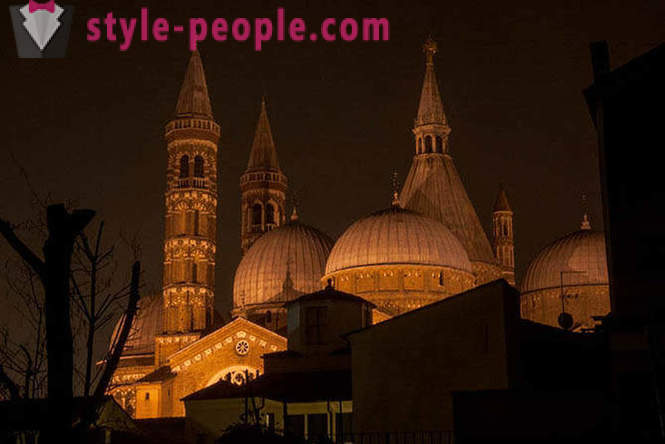
This temple was awarded the honorary title of Papal Basilica, with direct subordination to the Holy See (total of 10 temples, of which only 5 out of Rome).
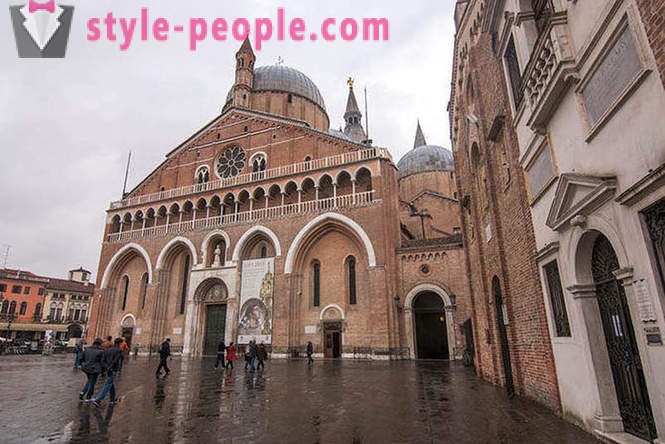
In the middle of the XV century. in Padua for over 10 years I lived Donatello. His first work was the famous equestrian statue of the ruler of the city - condottiere Gattamelata. The original still stands near the Basilica of Il Santo.
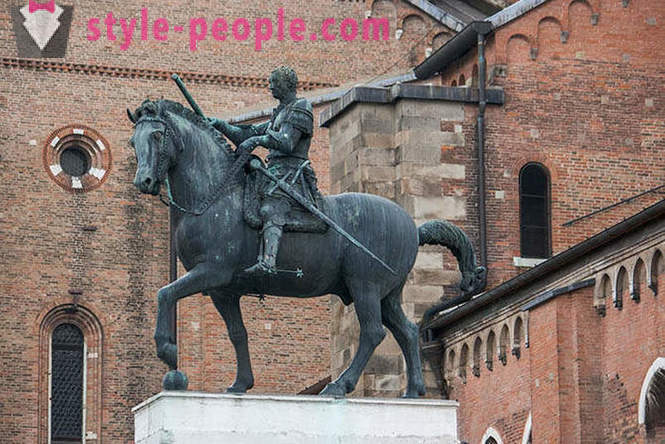
Around the same years, Andrea Mantegna creates a fresco "St. Anthony and St. Bernardino of Siena in the monogram of Christ" over the entrance to the cathedral. Now the facade you can see a copy of the original in Antonianskom museum.
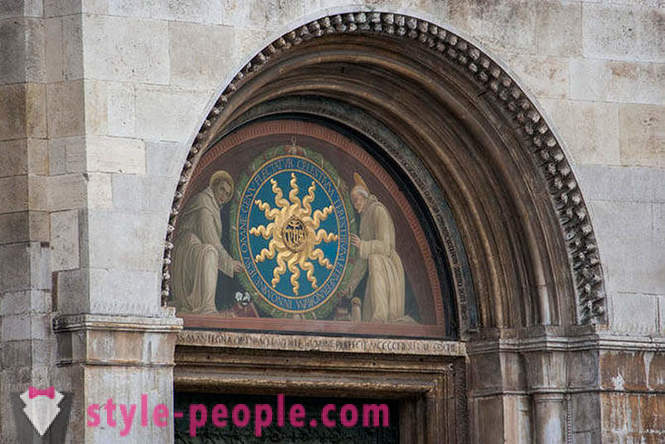
The interior was subjected to various changes since it was built in the early XIV century. up to our days.
The second significant work by Donatello in Padua - the central altar. The initial draft of the great master was reconstructed several times. Fortunately, the preserved original sculptures and bas-reliefs, they built the altar of the XIX century.
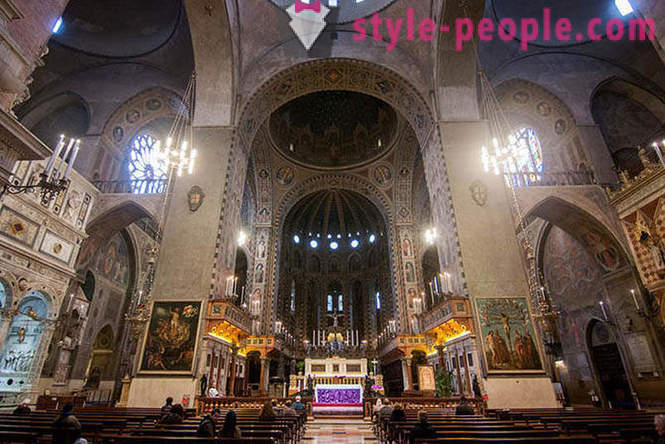
Total Donatello created 8 sculptures, "The Crucifixion" (author of the project was not included in the group of altar, and was placed in the choir of the cathedral), "Virgin and Child", "St. Louis of Toulouse "," St. Francis of Assisi "...
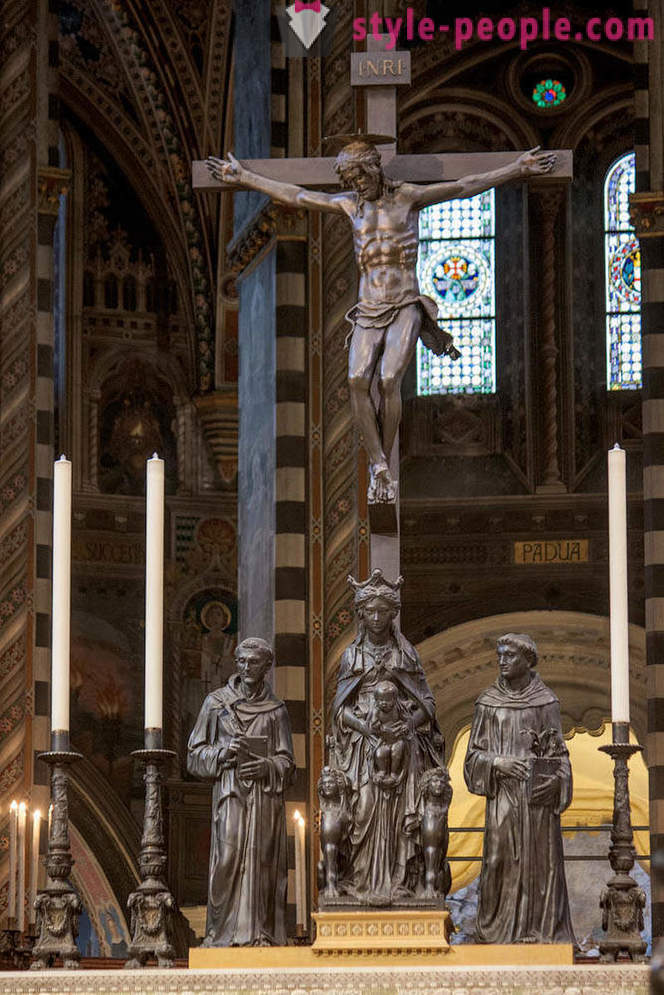
... and the four patron saint of Padua: "St. Anthony of Padua "," St. Justina of Padua "," St. Prosdotsy, the first bishop of Padua "and" St. Daniel Padua. "
Also belong to the hand of the master 11 relief plaques: "Burial of Christ" (in contrast to the other works executed in bronze, this - from limestone), four miracles of St. Anthony, have never been to portray;. their iconography was actually designed by Donatello's "Adoration of the mule, of the Blessed Sacrament," "The Miracle of the conspiracy Baby", "Resurrection of the boys" and "The Miracle of the heart of a miser," the four evangelists symbol "Eagle of St. John." "Angel of St. Matthew. "," The Lion of St. Mark "," Taurus St. Luke ', and the two tablets with the angels.
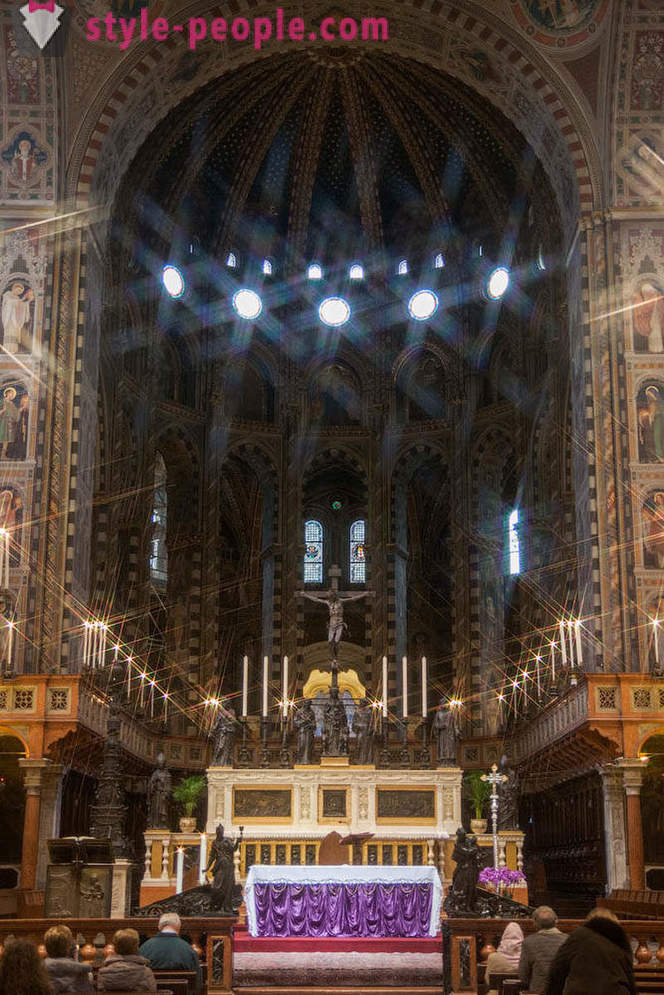
In the second half of the XIV century. condottiere Bonifacio Lupi instructs the construction of Capella St. James architect andriol de Santi. Later, for the frescoes of the chapel were hired Altichiero and Jacopo Avanzi.
Artists create cycle plots on the life of St. Jacob.
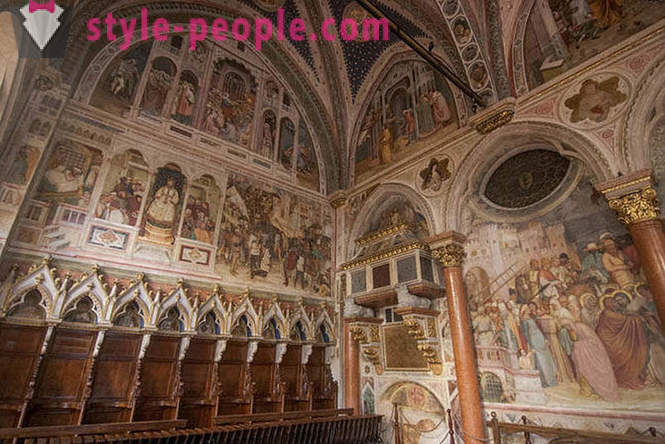
Later, Altikero has single-handedly created one of his major masterpieces - "The Crucifixion", occupying the entire central portion of the back wall of the chapel. Especially note the artist's attention to everyday detail in the crowd and mastery of color.
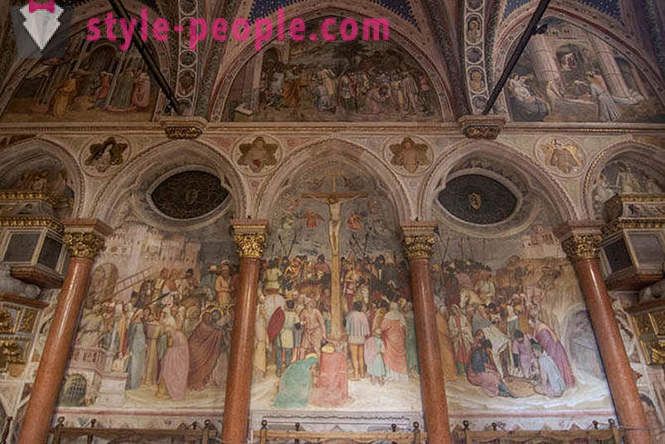
Capella "della Tomba" (Holy Sepulcher) was built in the XVI century.
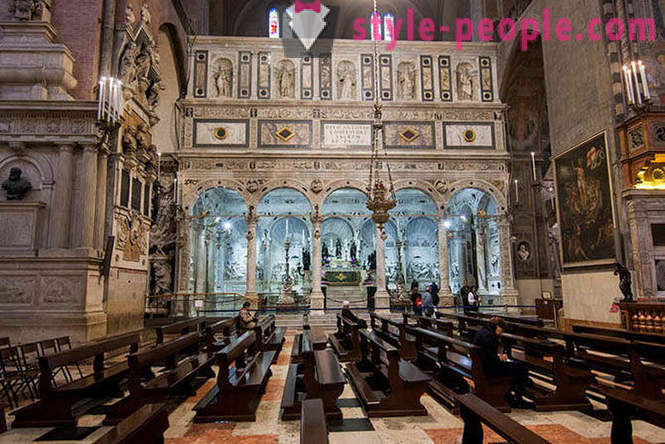
The central altar, which is the marble tomb, surrounded by nine bas-reliefs with scenes on the theme of the life of St. Anthony.
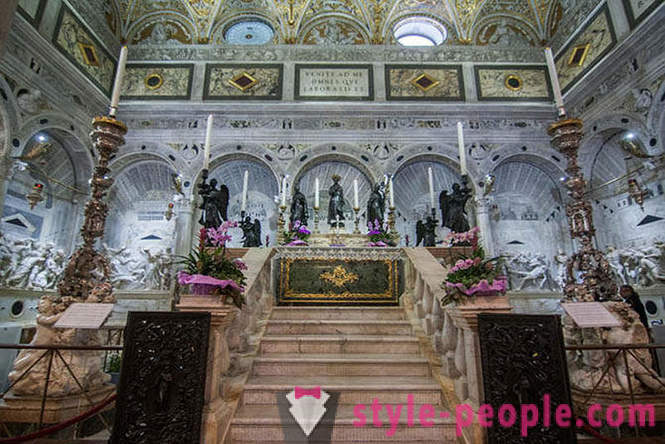
In the next photo - barelef "Miracle heart miser", work by Tullio Lombardo.
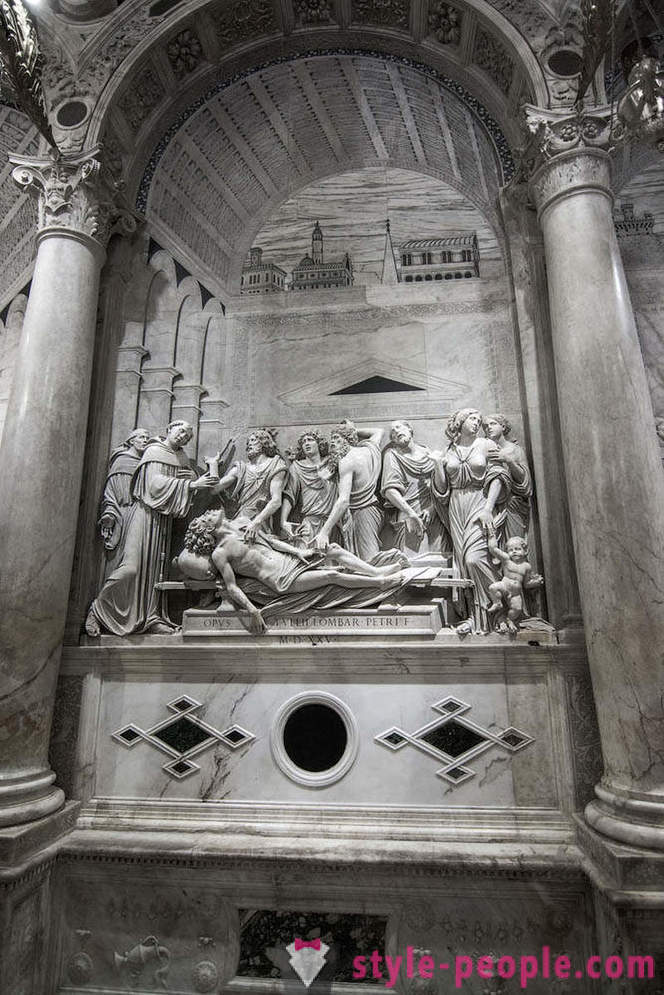
"The Miracle of the penitent", as Tullio Lombardo. The history of miracle is this: young paduanets hit his mother leg, and then, in order to atone for his sin, cut himself with both feet, misinterpreting the answer of St. Anthony during confession.. Rumors about such a severe punishment quickly spread through the entire city, St. Anthony came to the unfortunate, and seeing that he sincerely repents, put both feet on the former place, and they miraculously rooted.
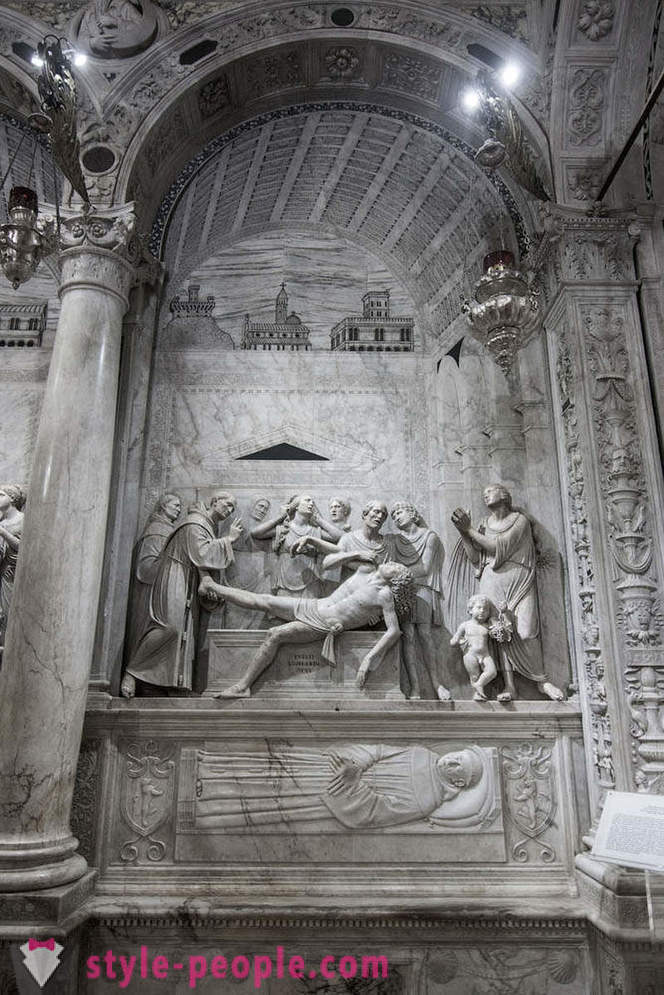
"The Miracle of the conspiracy and Child" - the work of his younger brother Tullio - Antonio Lombardo. The man suspected his wife of infidelity and renounce the newborn. After the prayer, the Holy, the baby is clearly confirmed that the born of his legal father.
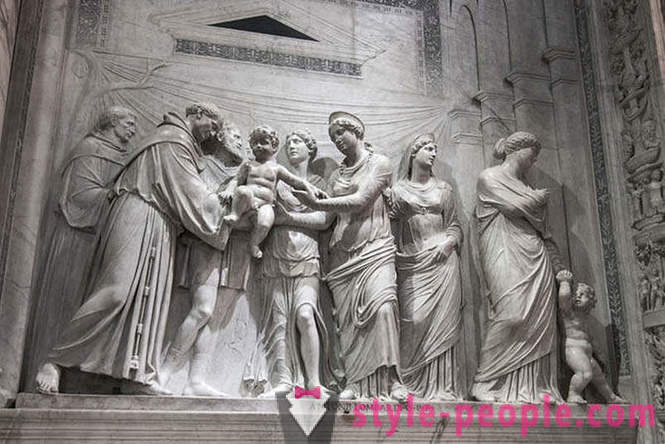
Other reliefs made by Jacopo Sansovino, Antonio Minella and other sculptors of the XVI century.
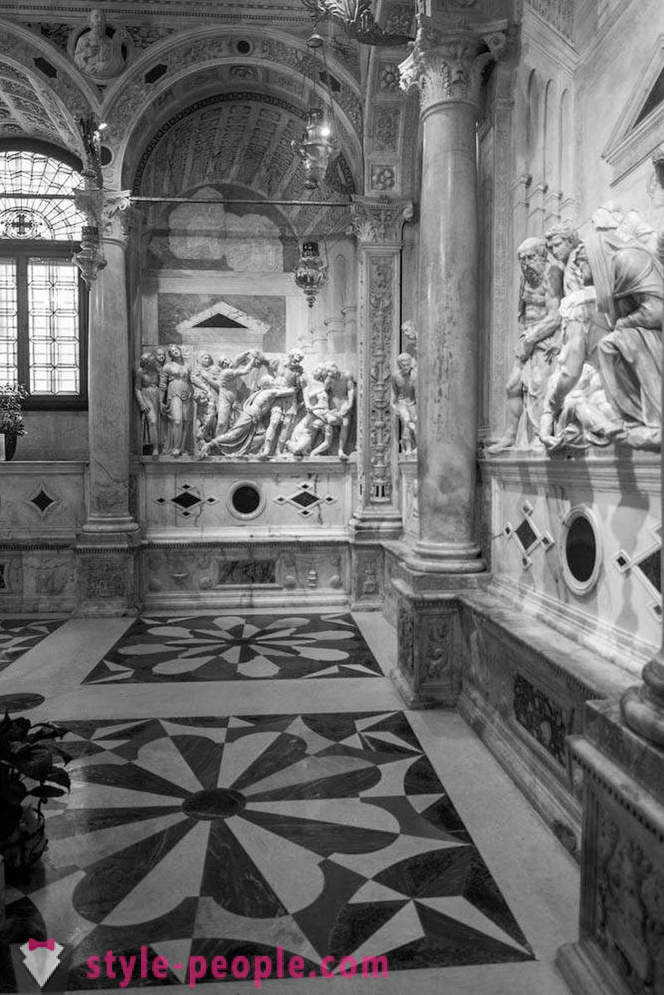
The individual parts of St. Anthony body (speech apparatus, language, and if not mistaken, the knee portion), which is believed to have particular force exhibited in a specially constructed Capelle Treasure. Chapel designed by the very pupil of Bernini - Filippo Parodi. Unfortunately, photo inside forbidden.
Incredible impression Chapel of the blessed Luca Belludi (satellite ST. Anthony's in the last years of his life). The walls and the vault 68 Chapel decorated in frescos end XIV. brush Giusto de 'Menabuoi and his disciples. Stories - the lives of the apostles James and Philip, a few episodes in the life of Luke Belludi and "Crucifixion" and the center of the chapel - "Virgin and Child".
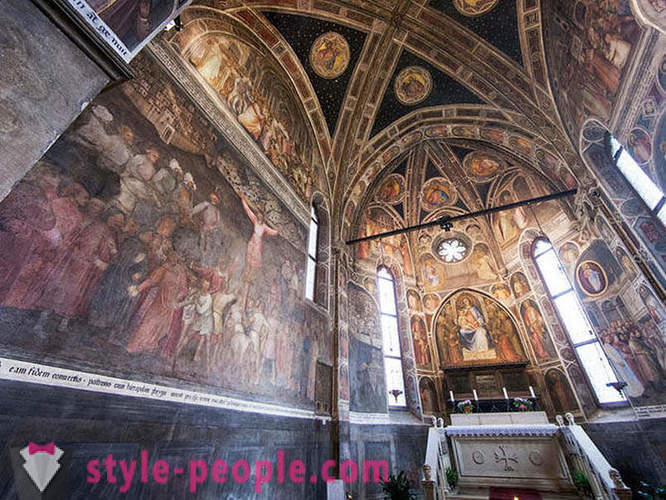
On the first left pillar of the nave is a "Madonna del pilasters." Madonna and Child - the XIV century. Stefano da Ferrara, was subsequently supplemented by the figure of John the Baptist and John the Evangelist Altikero students at the beginning of the XV century. Nearby is also a fresco of the XIV century. "Madonna Enthroned with Child" attributed to Guariento di Arpo.
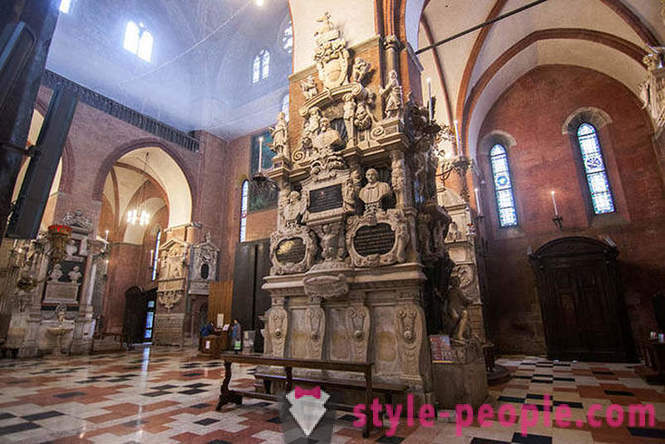
The vast space of the vaults of the central nave and the altar of the chapel are decorated with frescoes of the XX century.
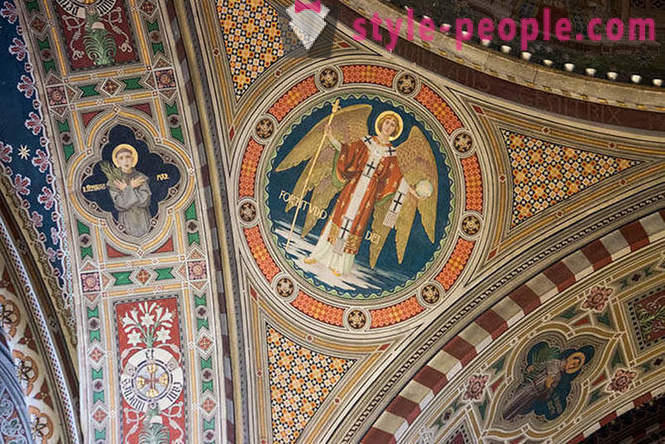
The composition of Il Santo enters and Franciscan monastery, which existed even before it arrived in the city of St. Anthony. The last major restructuring was carried out in the XV century. The monastery was divided into 4 buildings with a cloister. The main cloister (from the XIX century -. Magnolia cloister, from behind a tree planted in the center).
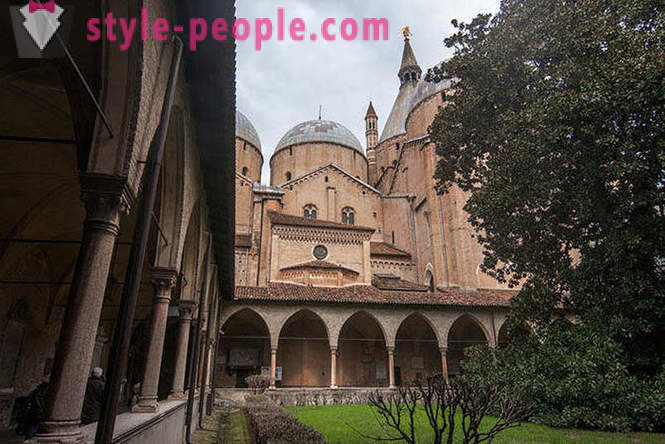
Along the walls are tombs of noble citizens XIV-XVI centuries., Two of which are decorated with frescoes Altikero and Giusto de 'Menabuoi.
It is because of this cloister is best noticeable similarity of the complex with the Cathedral of Agia Sofia and even mosques architect Sinan (eg - with Mosque Sokkolu Mehmet Pasha) and his students - Davut Aga (New Mosque) and Sedefhara Mehmet Aga (Blue Mosque), also based on Byzantine architectural traditions.
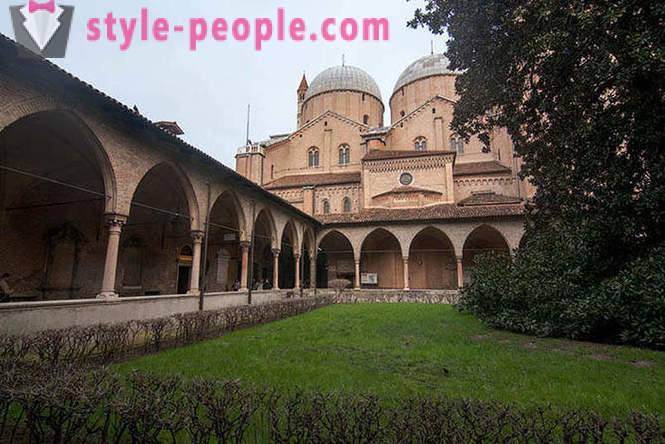
Generali cloister and adjacent buildings were Padua residence of the head of the Franciscan order.
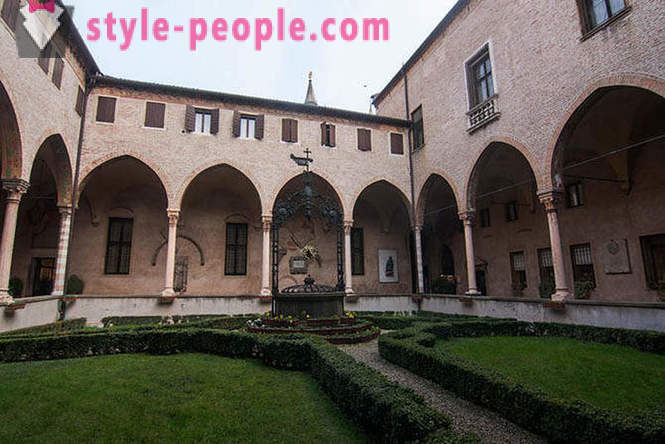
The other two cloister - "Paradiso" (looks like "cloister Magnolia", built on the site of an old Franciscan cemetery) and "Novitsato" (looks like "Generali", is still used by novices, aspiring to join the Order of the series). From the "Paradise" can be reached in Antoniansky Museum. It is here that kept the original facade with a lunette by Andrea Mantegna.
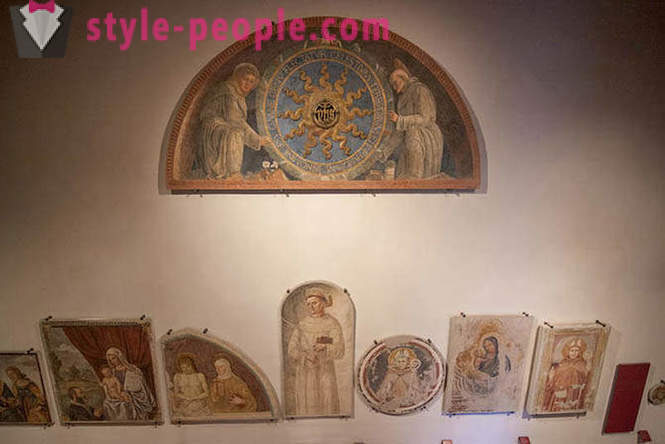
ollektsiya quite impressive. The central place is occupied by "Pala di San Frenchesko di Pirano" Vittore Carpaccio (picturesque town of Piran belonged to the Venetian Republic until its fall at the end of the XVIII century. Now it is the territory of Slovenia. The painting was moved from the Piran church of St. Francis Basilica Il Santo to save during World War II). . Chapel of the Basilica of St. Agatha was pereosvyaschena in the chapel of St. Rose of Lima, the altarpiece -. "The Martyrdom of St. Agatha." Gianbattista Tiepolo is now also in the museum. Also pay attention to the painting "The Beheading of John the Baptist" Gianbattista Piazzetta, and an impressive collection of church vestments of various ages, including the personal mantle of Pope Sixtus IV.
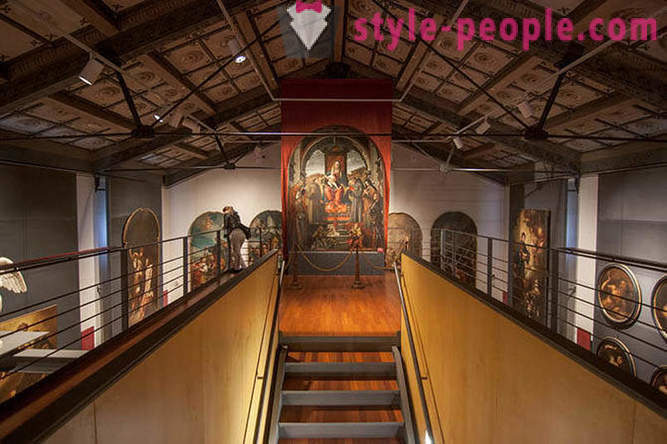
Close to the Basilica of San Giorgio was attached chapel. Raymondino Lupi, the Marquis of Soragna city, began construction in 1376, as a funeral chapel. After the death of the Marquis, his nephew Bonifacio Lupi completes Chapel.
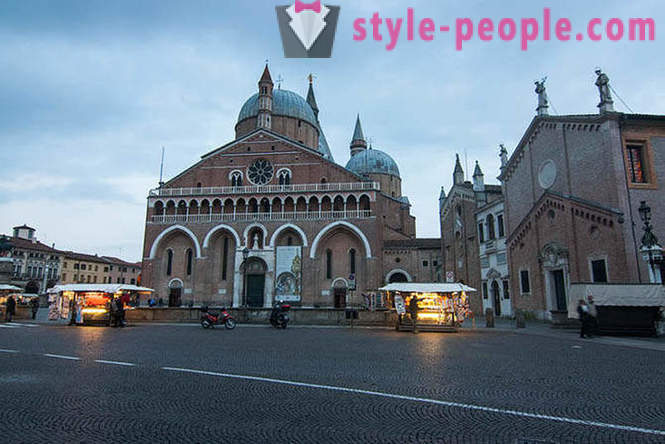
At that time already painted the chapel of St. James inside the basilica and proven Altikero was completed receives the order to decorate the walls and ceilings.
The artist creates a stunning fresco cycle. On kontrfasade scenes from the New Testament. Topics of the right wall devoted Lives of St. George, the left -. Catherine of Alexandria and Lucy of Syracuse. In the altar of the fresco "The Crucifixion", which is considered one of the most outstanding works of Italian painting of the XIV century.
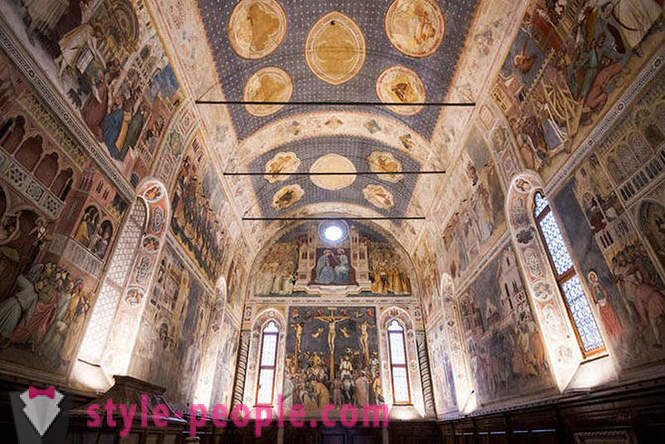
adjacent to the chapel building - Scuola del Santo or Skoletti. The building was built in the middle of the XV century. and served as the private chapel of the brotherhood of St. Anthony.
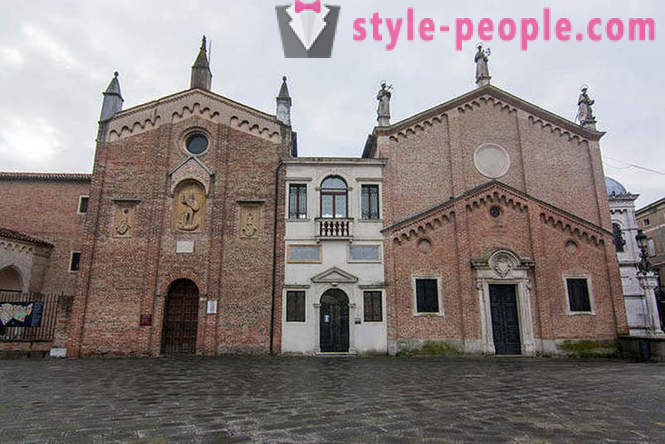
At the beginning of the XVI century. construction of the second floor - a spacious meeting room. Immediately after construction, the hall is decorated with frescoes depicting the life of St. Anthony. Young Titian, who moved to Padua to escape from the Venetian plague, gets her first big order was here; his hand has three murals: "The Miracle of the conspiracy and Child", "The Miracle of the jealous husband," and "The Miracle of the penitent."
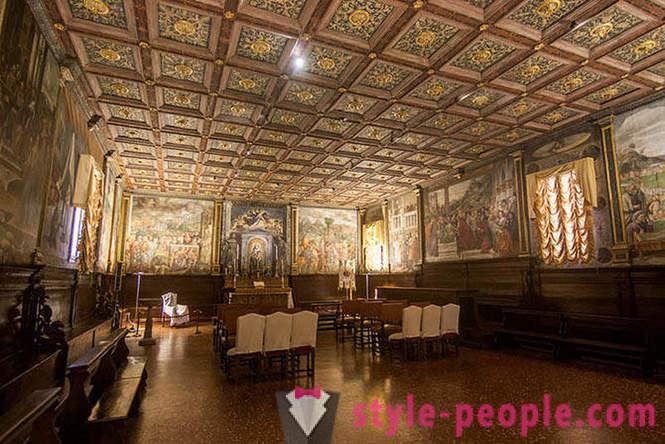
Other murals hall - works Francesco Vecellio (Titian's elder brother), Bartolomeo Montagna, Domenico Campagnola and others.
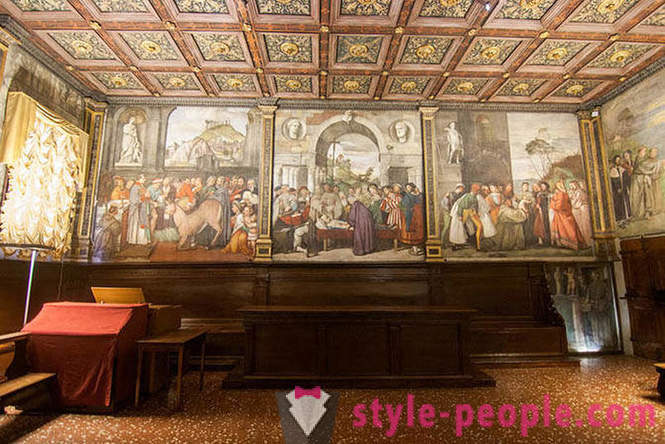
In the XVIII century. staircase connecting the church to the hall and the courtyard rebuild the project by Giovanni Gloria.
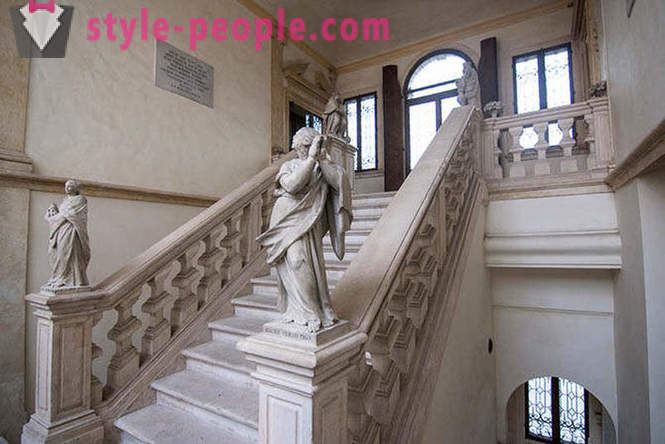
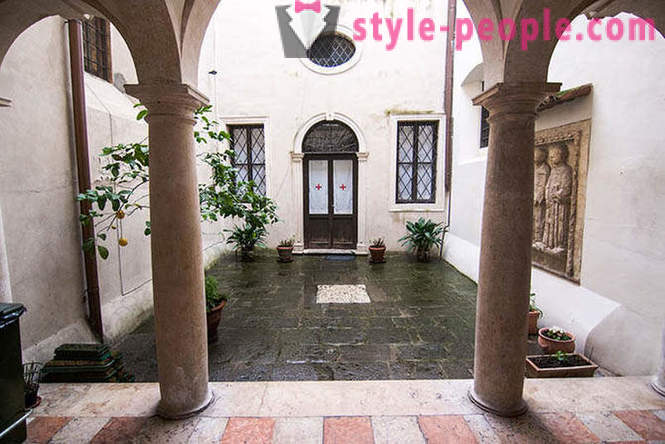
In the southern part of the historical center of Padua, it is the largest square in Europe - Prato della Valle.
Once this place was Champ de Mars and the ancient Roman amphitheater. However, a major flood in the end of VI. It transformed the area into a swamp. For centuries, the inhabitants of the city were trying to resurrect life here, but it could only in the XVIII century.
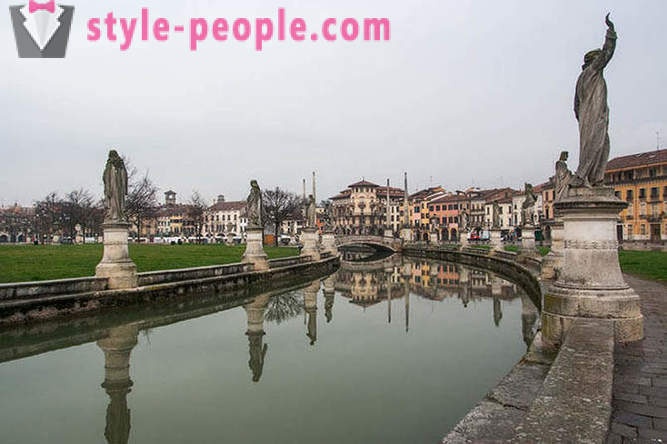
Under the leadership of Andrea Memmo policy built oval channel and a system of underground hydraulic structures. Subsequently, the channel has been decorated with 88th statues depicting iconic historical figures for Padua. Has survived only 78 statues - 10 of them depicting the Venetian doges, they were destroyed by order of Napoleon.
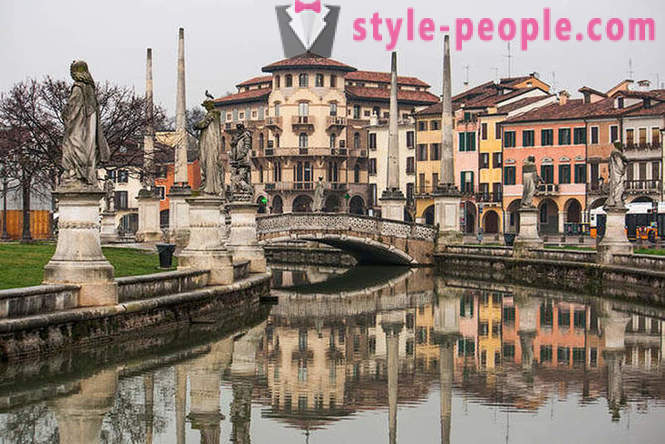
In the south-eastern side of the square there is a huge (nave length - 120 meters) Basilica of Santa Giustina.
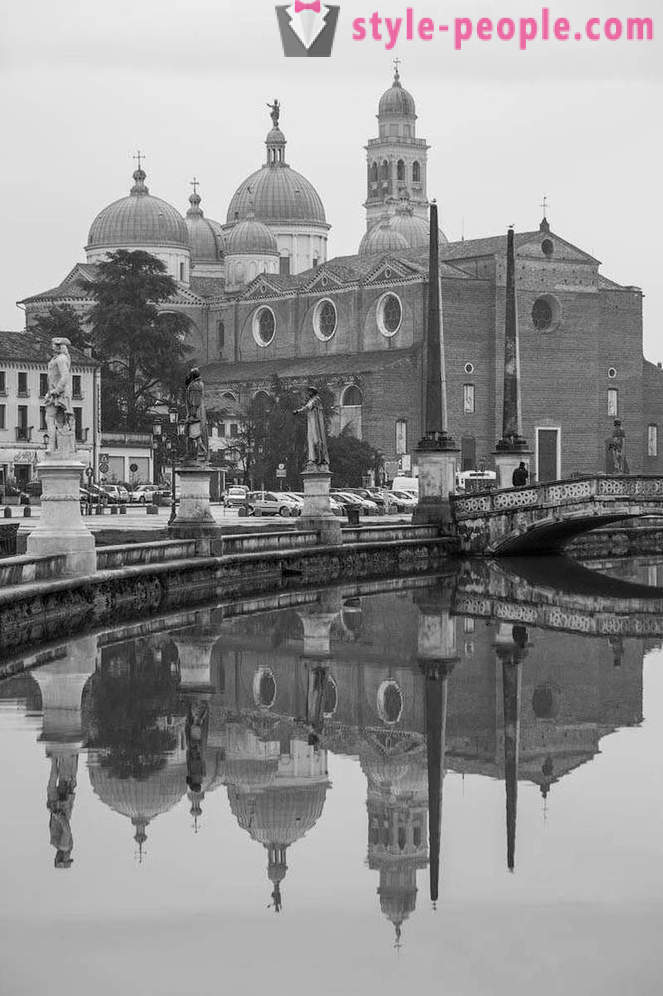
The first church on the site of the basilica was built in the early Christian burials, among which were found the relics of the first bishop of Padua -. St. Prosdotsiya (disciple of St. Peter.) And his goddaughter - Martyr of St. Justina of Padua..
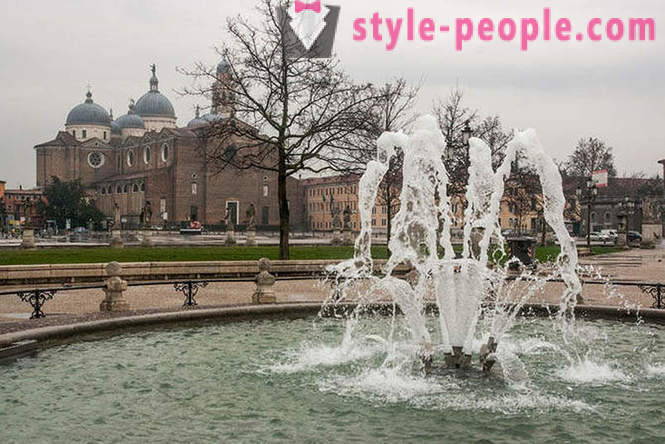
The present building was built with the XV to XVII centuries .; this is the first major structure built on swamps Prato della Valle after the flood, a long time it remained one of the biggest buildings in the world.
Cathedral with a dome in the Byzantine style, like Il Santo.
to this day the facade is not finished, but the 2000s are considered various projects on its completion.
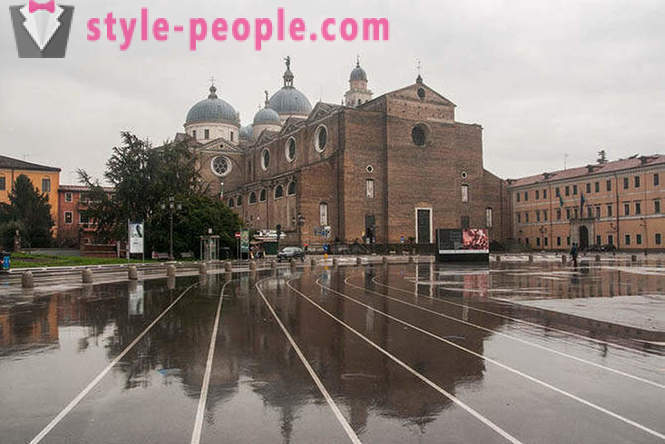
Interior, due to the size of the space, it seems a bit empty. In fact, there is something to see: the altarpiece - "The Martyrdom of St. Justina." Paolo Veronese (considered one of the best works of the master).
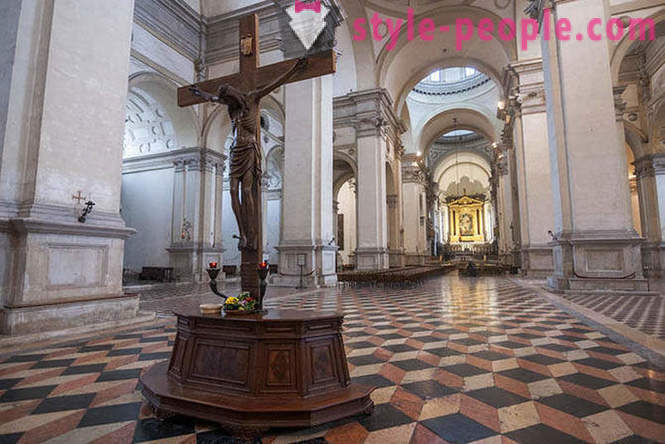
Basilica is incredibly rich in relics. Here are stored the relics of Luke and Matthew, Maximus the Confessor, Julian Hospitable and, of course, the newfound power of the previously mentioned Padua patrons (!) - St. Prostotsiya and St. Justina... Despite this, the neighboring Basilica of St. Anthony pulls the absolute majority of the pilgrims.
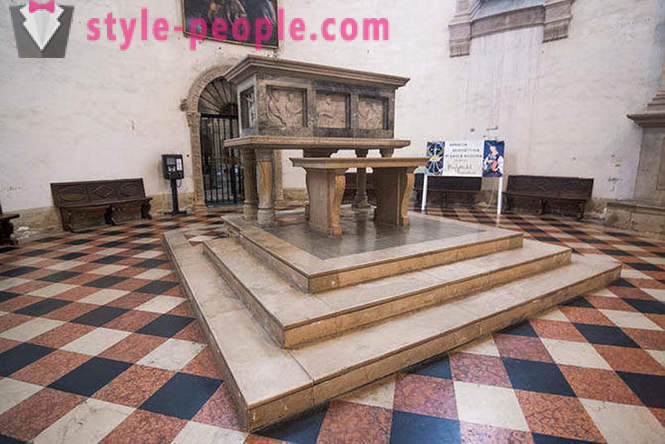
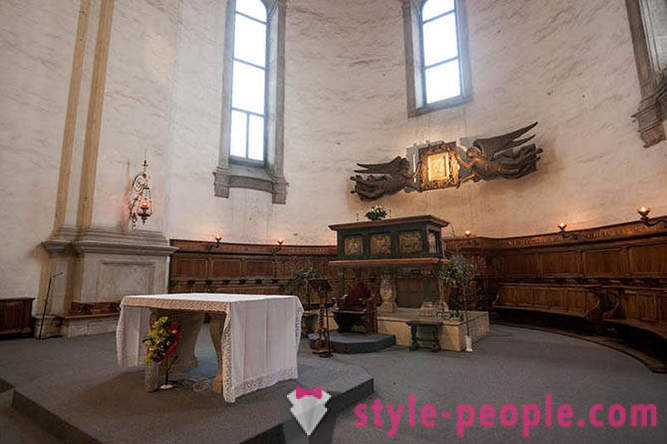
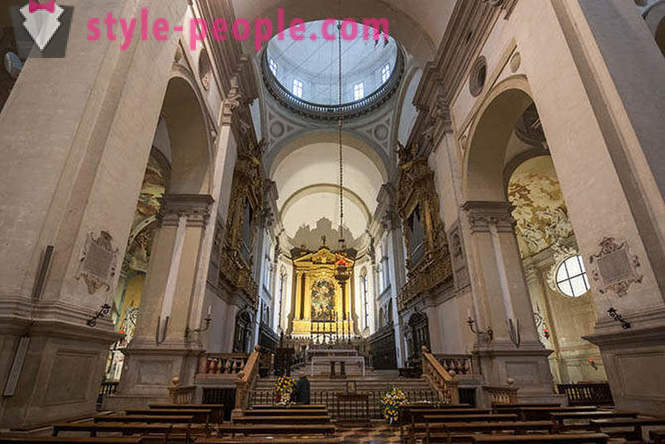
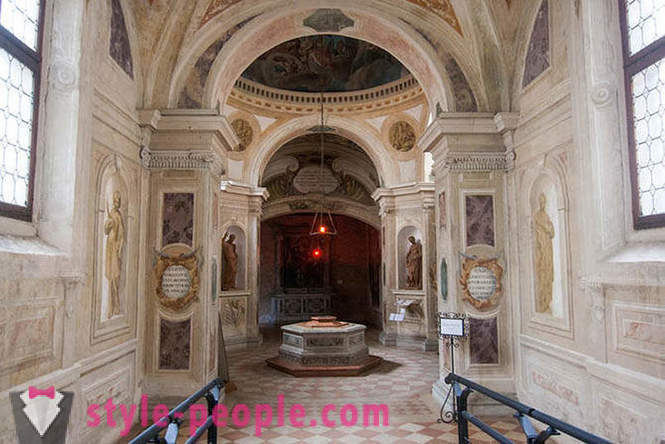
On the other side of the square - Loggia Amulea. This neo-Gothic palace used by the whole XX century as a fire station. Today, the administrative offices are located here.
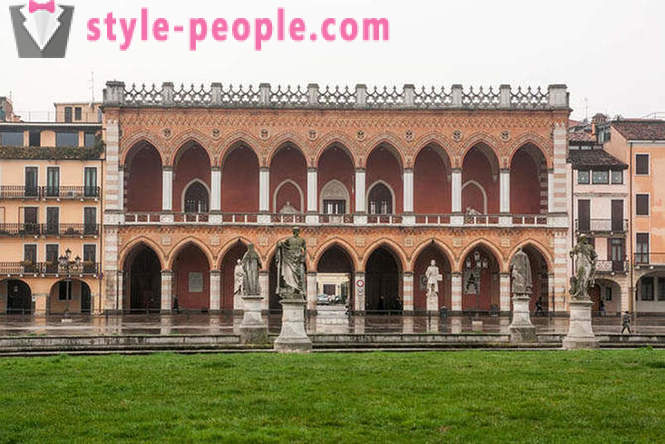
Finally a few pictures from Prato della Valle.
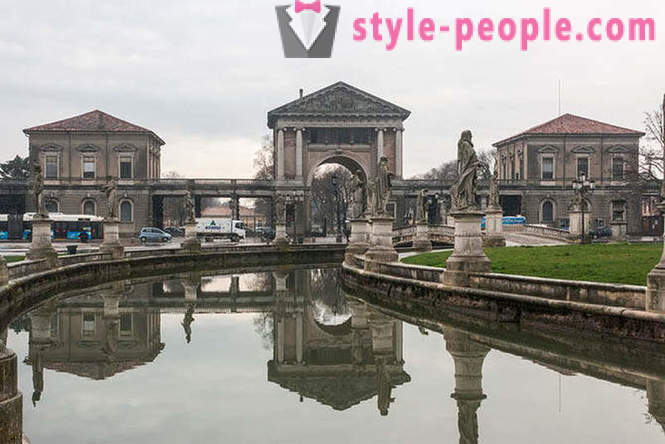
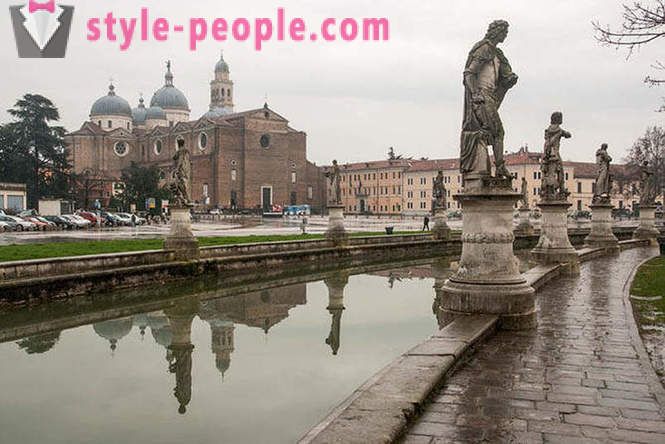
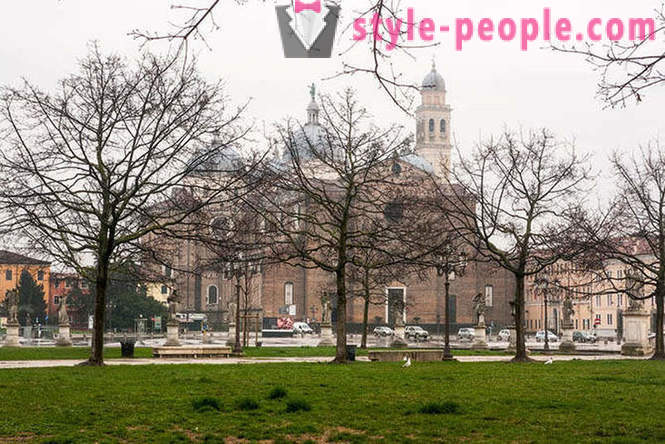
At the heart of Padua, there are several historical areas with the most important buildings of the city: the Cathedral, the Palace of hearings.
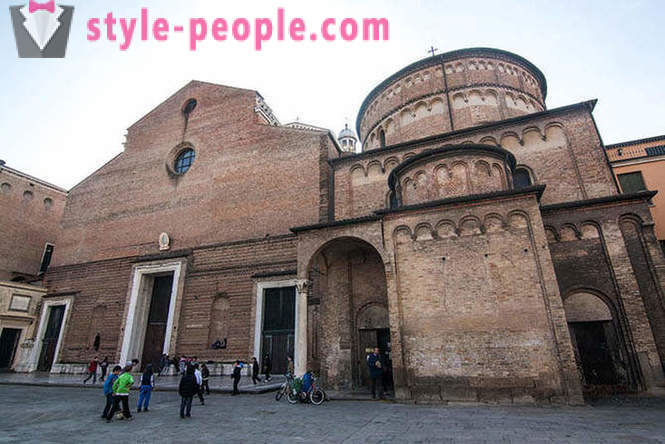
The Cathedral of the Assumption of the Virgin, also known as the Duomo, began to build in the XVI century., And was consecrated only in the XVIII century. Before him, at this point it was the early Christian basilica, destroyed by an earthquake in XII., And then Romanesque cathedral, later dismantled for the construction of the existing one.
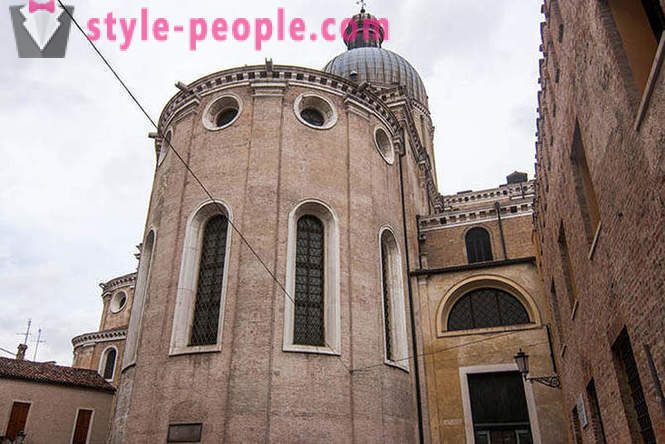
Episcopal College has announced a competition for the construction of the new Renaissance cathedral, which was won by a joint project of Michelangelo, Andrea da Valle and Agostino Righetti. In later centuries, the project repeatedly supplemented and varied parts. Facade, whose construction began in the last turn, was destroyed by a bomb during World War II, and since then has remained unfinished.
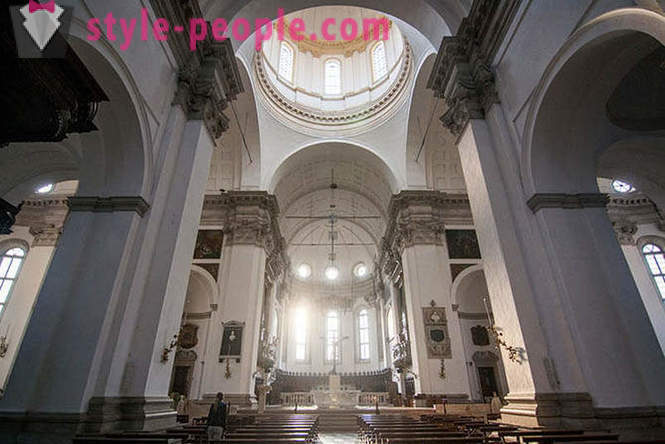
The interior is light and airy, but without any outstanding masterpieces.
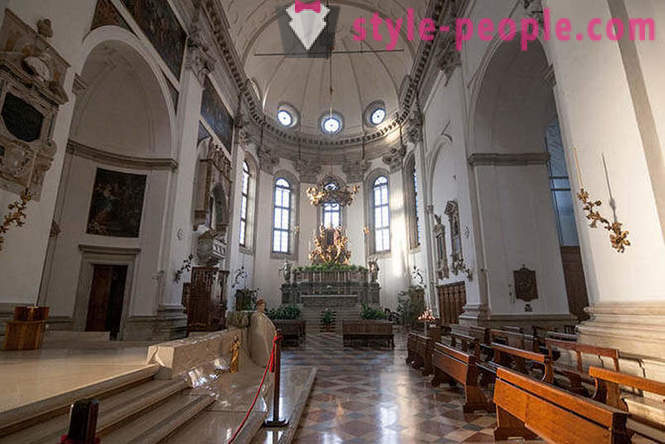
The present masterpiece lies in baptistery XII in., Which is preserved by the second, Roman temple. Inside - a stunning fresco Giusto de 'Menabuoi. Unfortunately, it was not possible to assess fully - inside now being restored, but some parts are already open. It looks like the dome, as well - one of the walls.
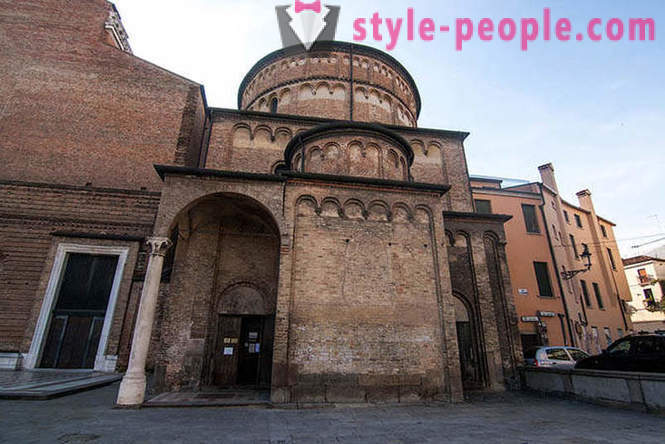
in the Dome Square is also the Palazzo del Monte di Pietà, once belonged to his father, Enrico Scrovegni. Today the palace belongs to the banking company; the building is used for organizing art exhibitions.
I was lucky and I got to the exhibition Pietro Bembo - he was a famous cardinal, philologist (he is credited with a significant contribution to the formation of the modern Italian language) and collector, as well as the founder of the first Italian museum of Renaissance art, which was in his home in Padua. Now his collection are scattered in museums around the world, and so to get to a show - a great success.
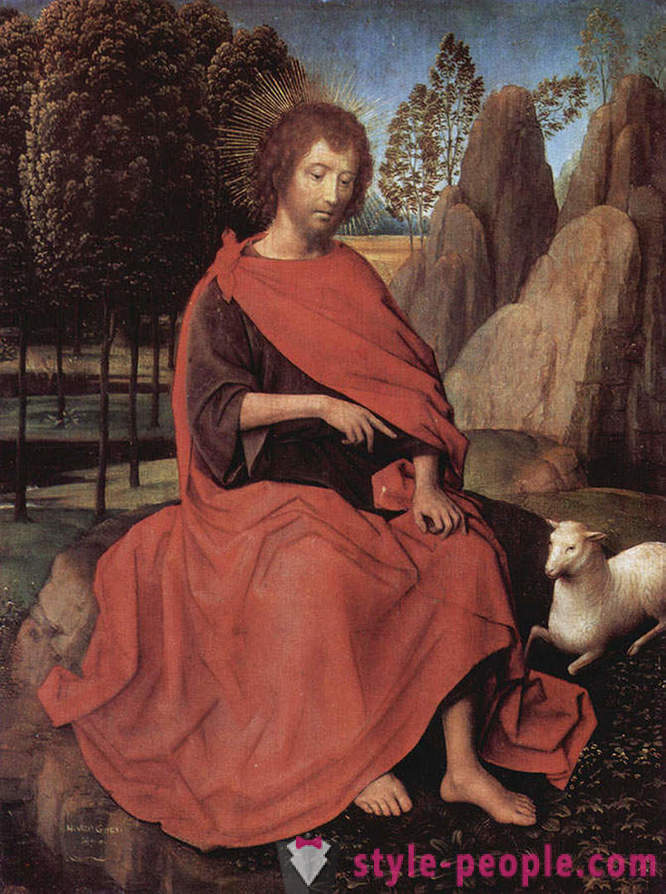
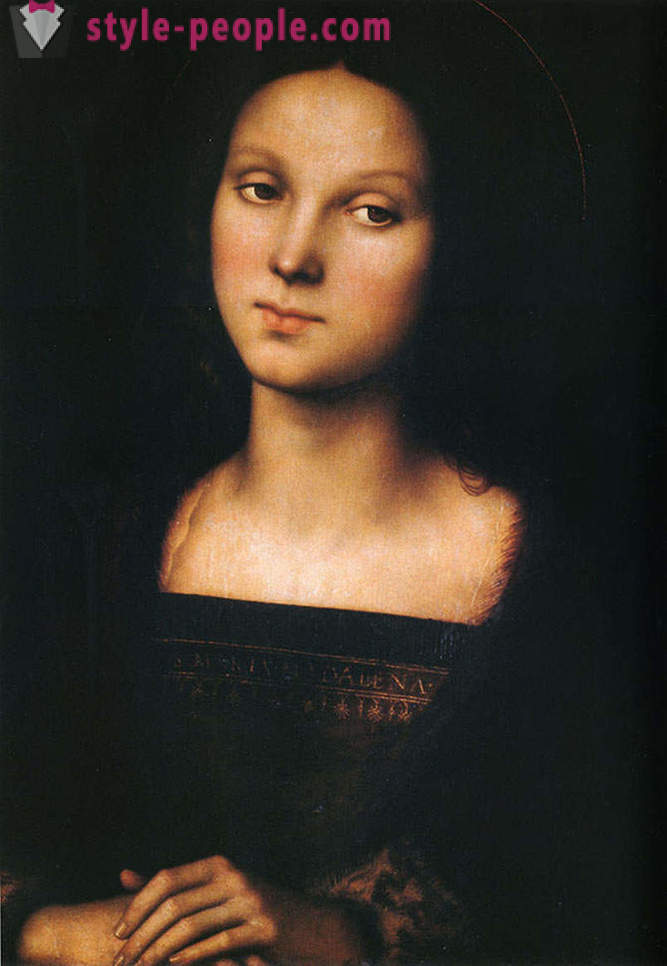
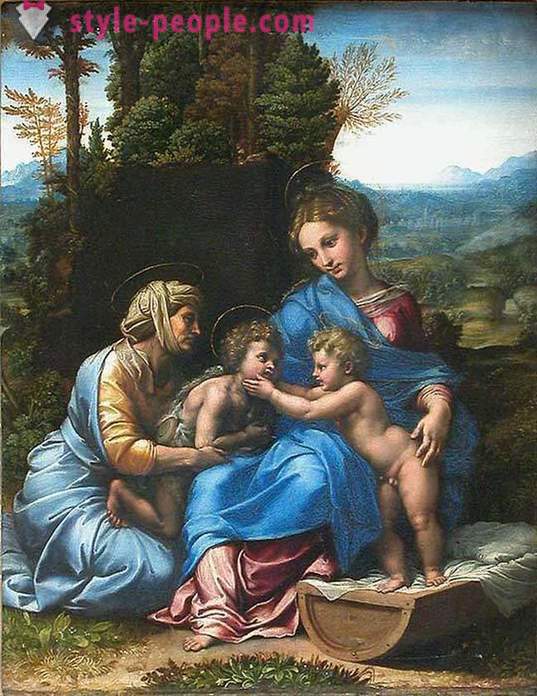
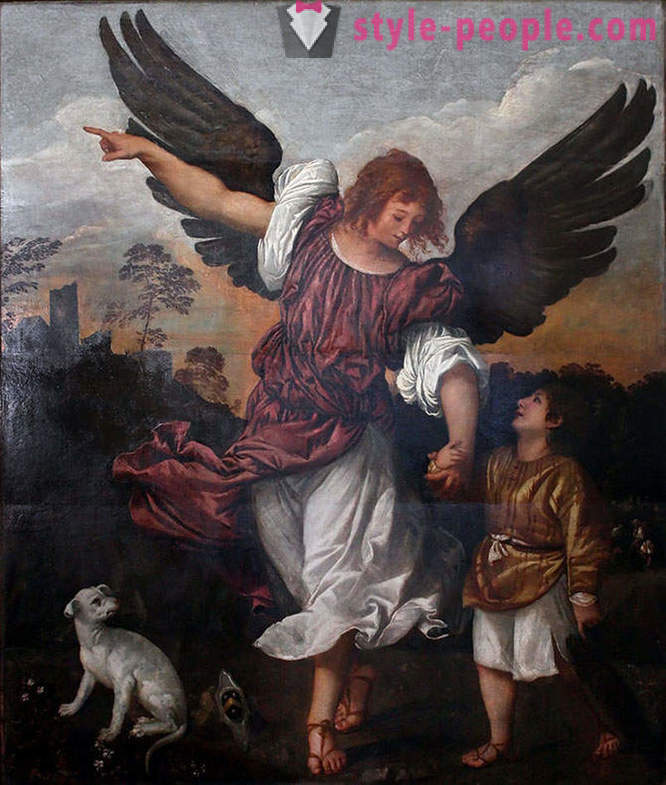
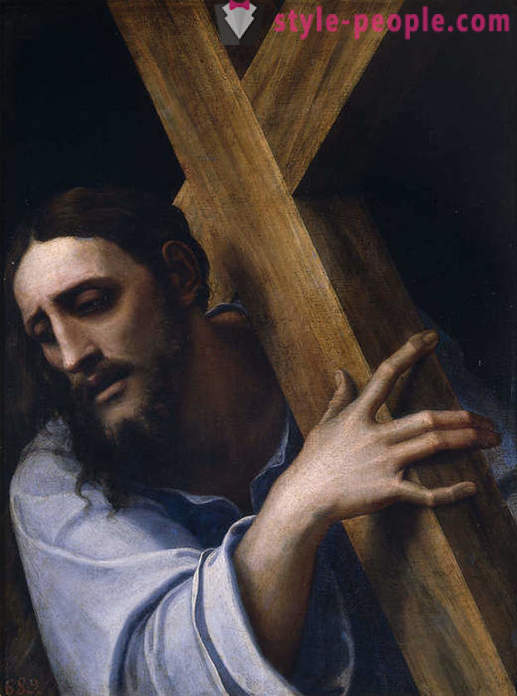
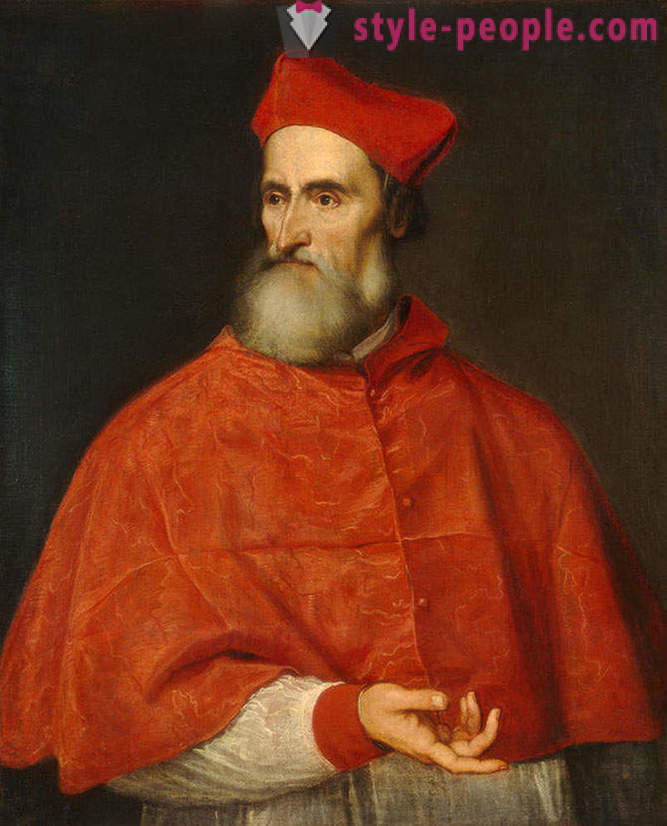
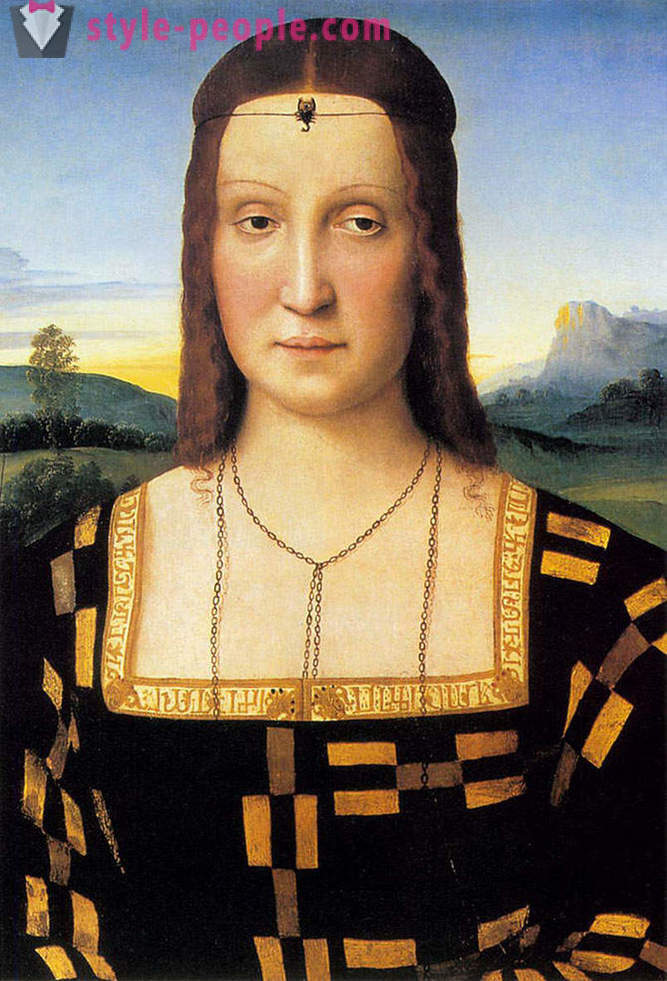
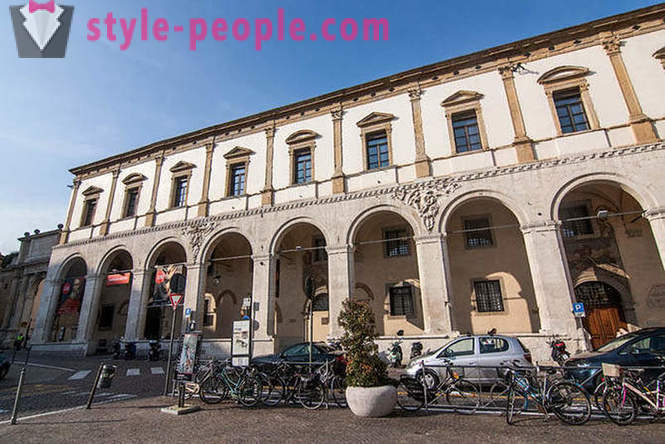
East of the Piazza del Duomo is the palace or the court proceedings Padua Palazzo della Ragione.
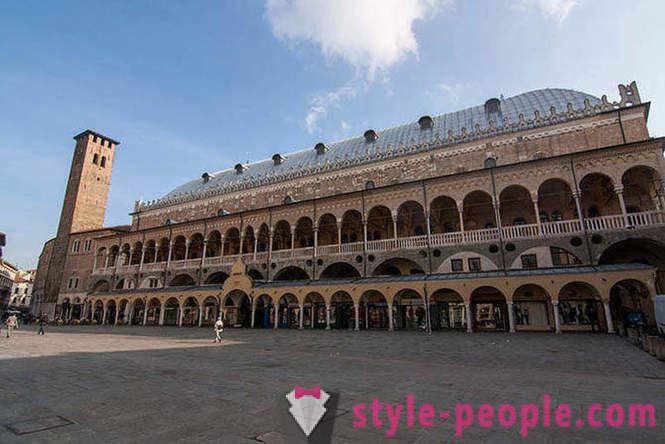
The Town Hall was built for 50 years, from the middle to the end of the XIII century.
The second tier of the building is surrounded by a beautiful gallery.
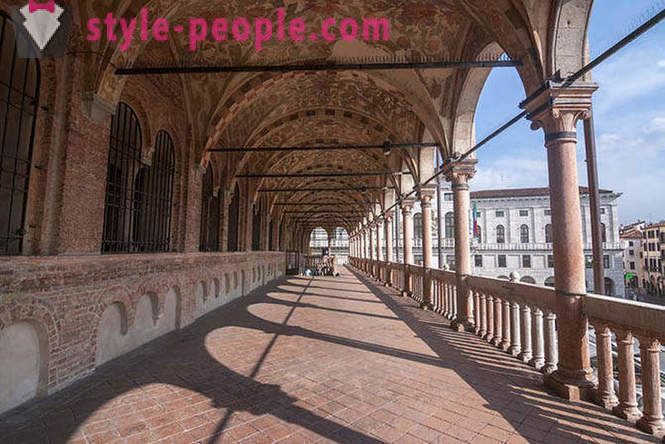
A characteristic feature of the building - the roof in the form of an overturned ship, project Eremita monk Giovanni. The roof had to be completely shift in the XVIII century. after she was entirely blown hurricane.
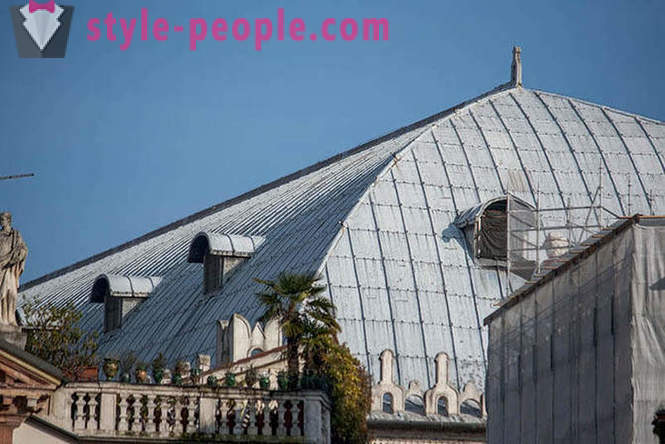
To visit the second tier is available, it houses the salon - it is one of the largest halls in the world. Initially it was used for meetings of the Municipal Court.
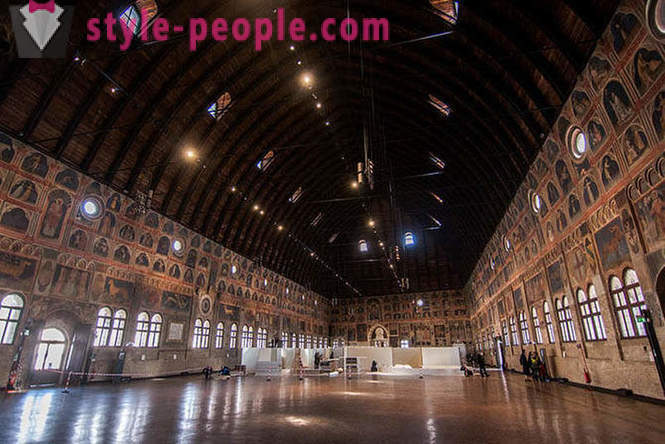
The frescoes on the astrological and religious themes preserved from the XV century. These murals were written after the fire and there is a version that the first frescoes of Giotto Salon wrote.
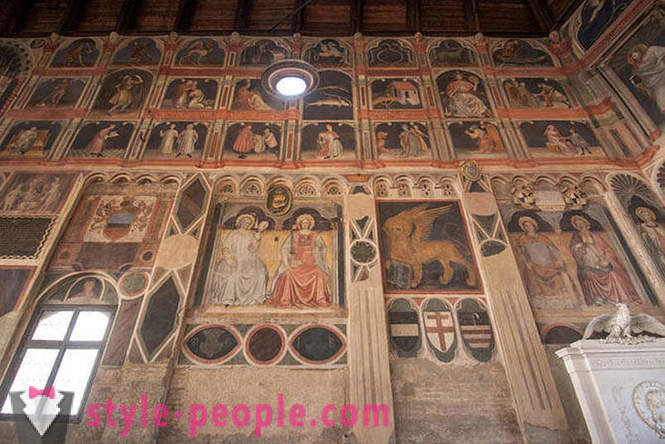
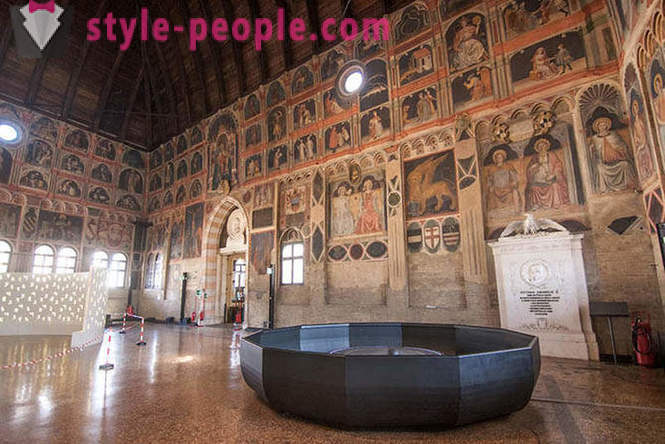
At the end of the hall is a wooden model of a horse Donatello Gatamelaty
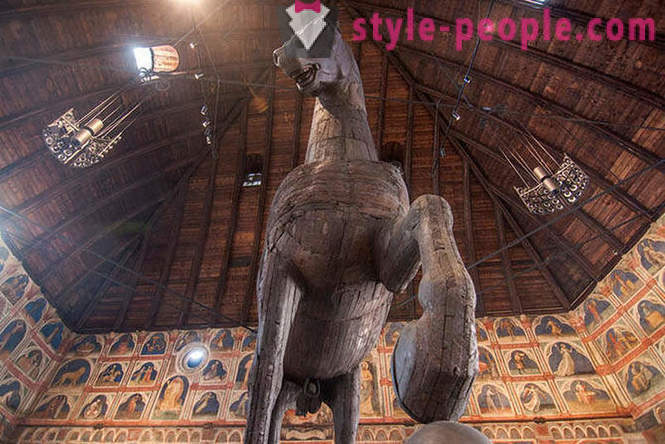
The Town Hall is located between the two marketplaces. One of them - Piazza delle Erbe ( 'area of grass'). It has maintained its market functions - tent with vegetables and fruits unfold here every day. Since the 2000s, there was a special tradition - the youth is going to Padua in Piazza delle Erbe every Wednesday and all they drink popular in the Veneto spritz cocktail (a mixture of Prosecco and aperitif Aperol).
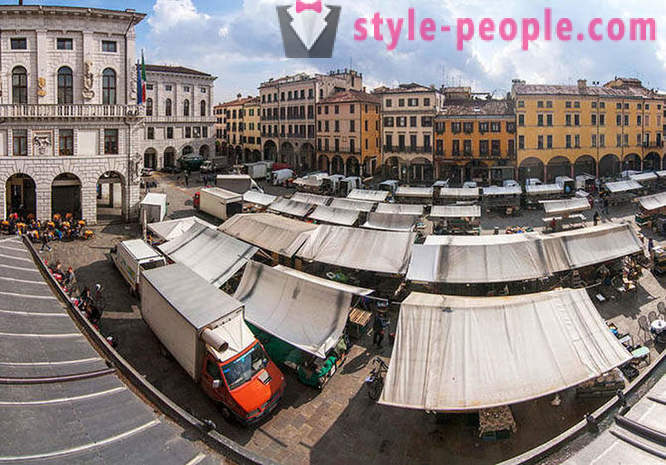
The second square - Piazza della Frutta ( 'Square Fruit'). There is sometimes carried out clothes fair, but generally the area is empty.
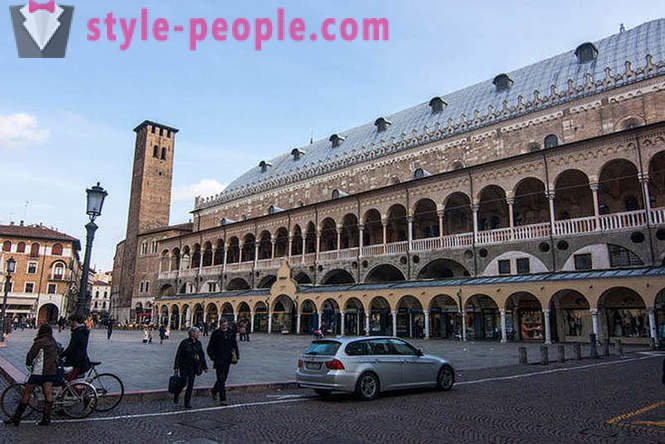
On the square is dominated by the Tower of Elders, it is the White Tower, XIII century.
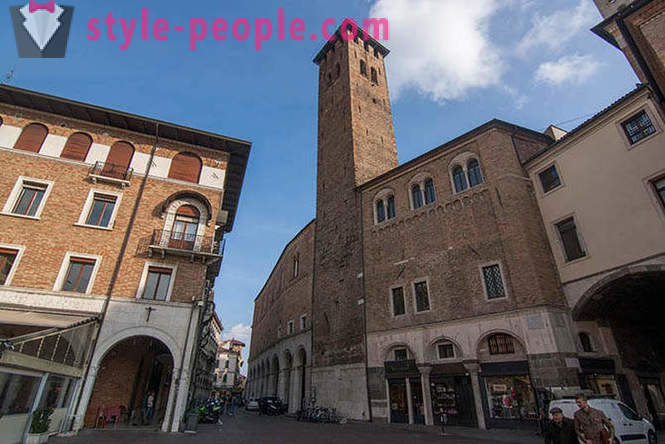
The Tower - part of the City Hall (Palazzo Comunale).
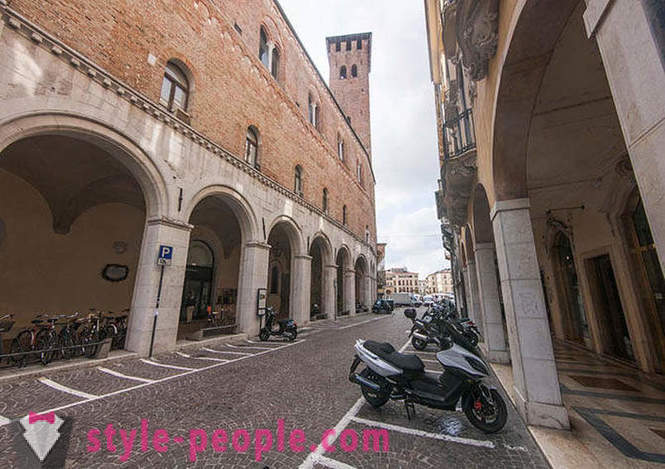
Hall Shells and their facades were built at different times - hence such an eclectic style.
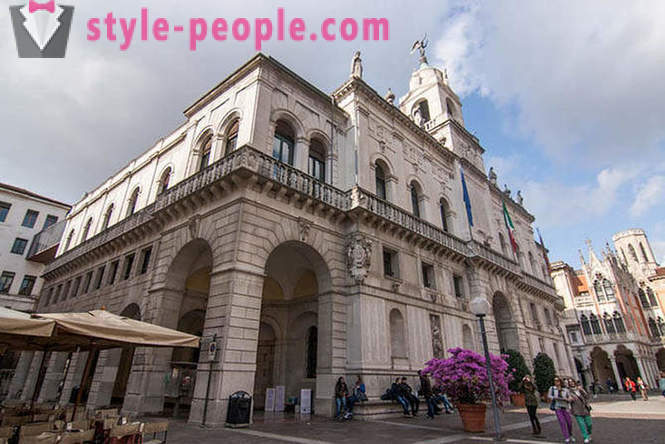
View of the Palazzo della Ragione.
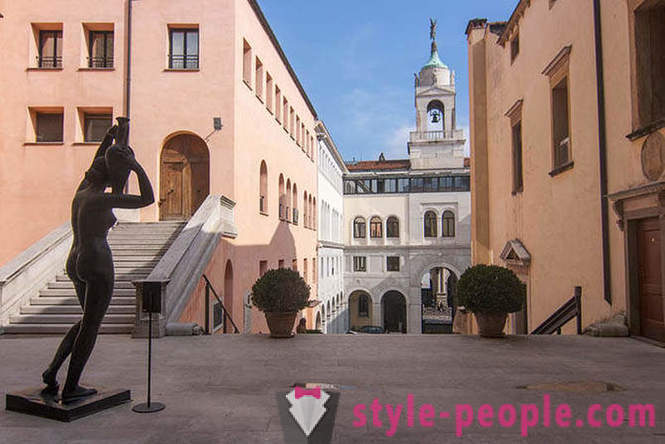
Between Piazza delle Frutti and Piazza Duomo - Piazza dei Signori.
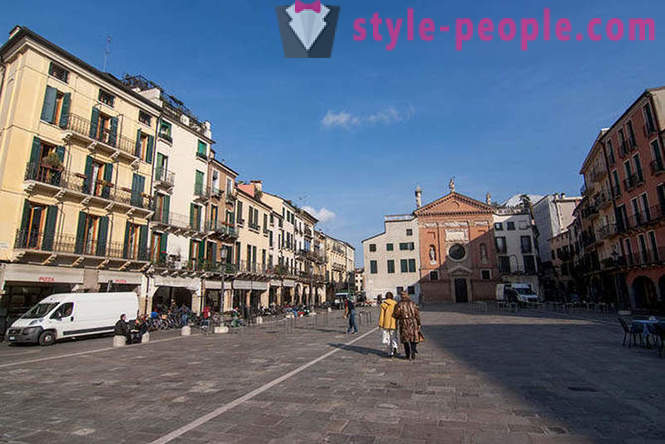
Here the immediately draws the attention of the Torre del dell'Orologio ( "Clock Tower '). Tower "sandwiched" Treasurers mezhdlu Palace and the Palace of the Captains. It was built in the XIV century., But then on it was placed among the first astronomical clock in Italy. They are almost completely rebuilt after a fire in the XV century .; still walking.
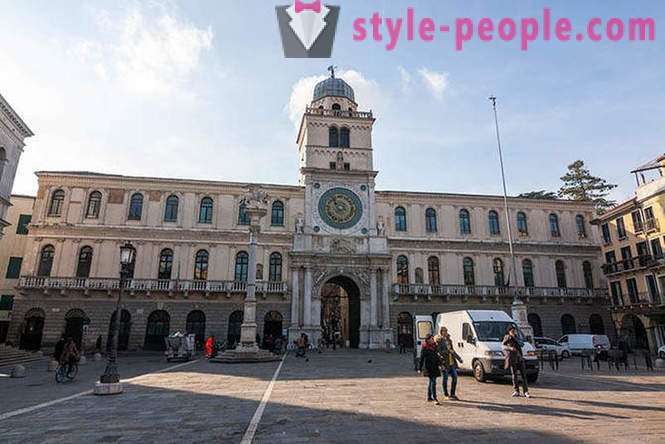
In the neighborhood - Loggia della Gran Guardia, XV century.
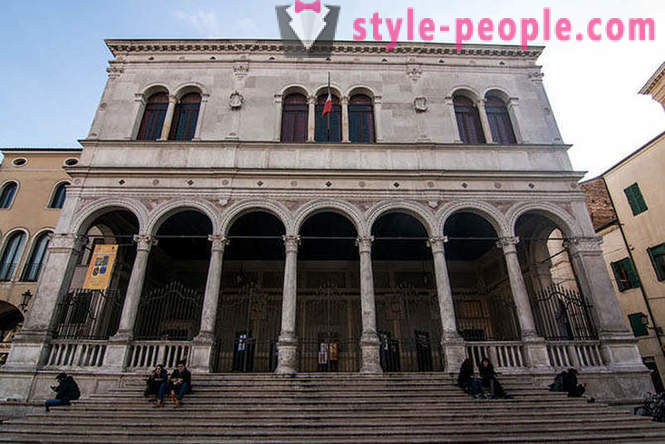
And on the other side of the square - the Church of San Clemente.
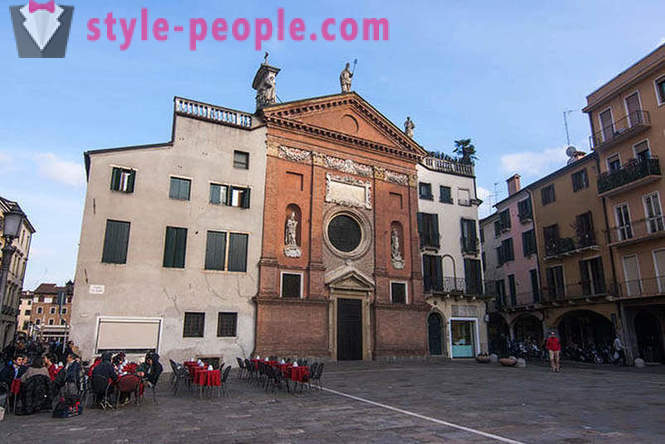
The small church of the XI century. was significantly rebuilt in the XVI century., then acquired has come down to our times façade, with figures of Clement and John the Baptist.
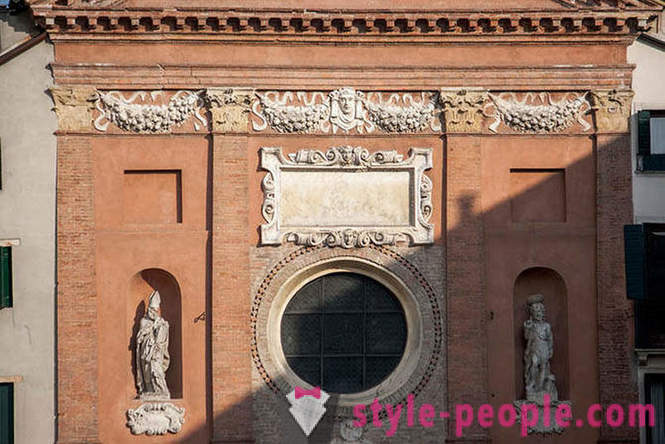
Finally - a couple of common types of streets in the area of Padua.
